What is customer segmentation?
Customer segmentation refers to segregating a business's customer base into different groups based on their shared characteristics, needs, and behaviors.
For example, an online clothing store might segment its customers as "frequent buyers," "seasonal shoppers," and "first-time visitors." The store can then offer personalized promotions such as loyalty discounts for frequent buyers, seasonal sale discounts for seasonal shoppers, or welcome offers for first-time buyers to each target group.
💡 Related guide: 9 Best Customer Segmentation Examples to Boost Sales
Why is customer segmentation important?
Customer segmentation is important because it ensures the right marketing messages reach the right people while preventing sending irrelevant emails that can frustrate them. This targeted approach helps to understand a customer’s needs, preferences, and painpoints and cater to them with personalized recommendations, leading to a good customer experience.
For instance, take a look at the welcome email below from Miro. Do you think sending this “Welcome” email to a customer who’s already been onboarded makes sense?
No, right?
It would lead to a poor customer experience as the customer has already been onboarded and know about the brand. It also leaves an impression that the brand doesn’t know its customers.

Customer segmentation offers other benefits as well, such as:
Increased sales: By offering relevant offers to the right audience, you can drive higher conversions.
Improved customer loyalty: Targeted communication shows customers you understand their needs, building trust and customer loyalty.
Higher customer engagement rates: Messages that resonate with customer interests are more likely to be opened, read, and acted upon.
Optimized marketing spend: Focusing resources on specific segments avoids wastage of resources and reduces marketing costs.
Types of customer segmentation
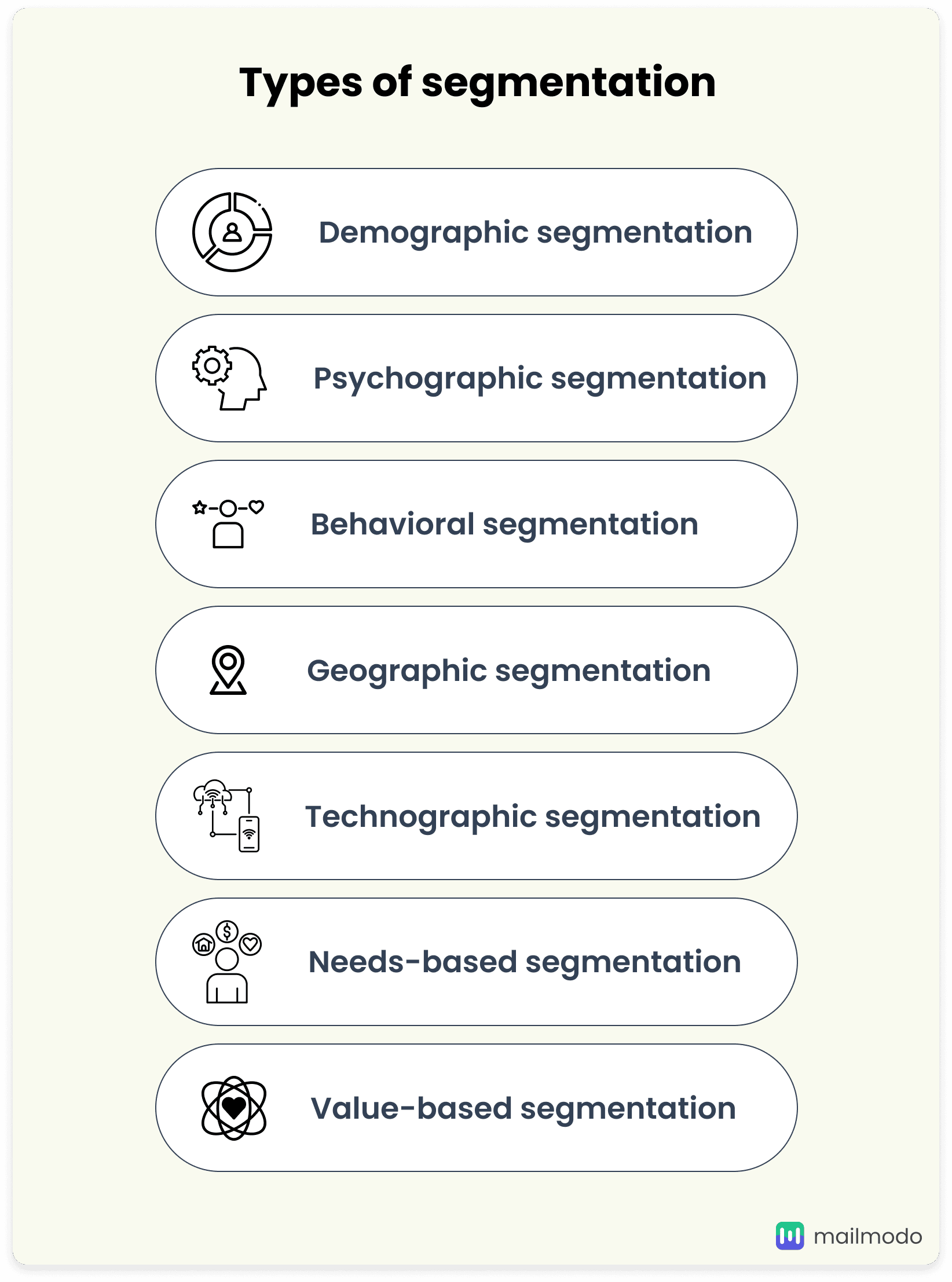 Segments are created based on specific criteria. Below, we’ve provided a table outlining these criteria.
Segments are created based on specific criteria. Below, we’ve provided a table outlining these criteria.
| Segmentation Model |
Criteria |
Example |
| Demographic Segmentation |
Age, gender, income, occupation, marital status, and education. |
Marketing luxury cars to high-income individuals. |
| Psychographic Segmentation |
Lifestyle, values, personality, interests, opinions. |
Recommending eco-friendly products to environmentally-conscious consumers based on psychographic data. |
| Behavioral Segmentation |
Purchasing behavior, usage frequency, brand loyalty, and benefits sought. |
Offering discounts to repeat buyers or loyalty program members. |
| Geographic Segmentation |
Country, region, city, climate, urban or rural location. |
Promoting winter clothing in colder regions. |
| Technographic Segmentation |
Device usage, software preferences, technological expertise, and internet usage. |
Promoting high-tech products to users of the latest smartphones. |
| Needs-Based Segmentation |
Pain points, problems, goals, required features, or solutions. |
Recommending software plans based on feature requirements. |
| Value-Based Segmentation |
Lifetime value and spending frequency. |
Offering VIP benefits to high-spending customers. |
How to build a customer segmentation strategy
Building a customer segmentation strategy can be confusing if you’re new to it. To help you, here’s a step-by-step guide you can follow.
Step 1: Define your objectives
Your objectives will form the foundation of your segmentation strategy. What do you want to achieve with segmentation? Do you want to increase sales, improve customer retention, or elevate customer experience? You must set clear goals before you start building your segmentation strategy.
Step 2. Collect customer data
Once you’ve defined your objectives, you’ll have a better understanding of what kinds of data to collect. You can collect important customer data through surveys, social media, focus groups, feedback forms, purchase history, and analytics tools.
If you’re going to be using survey and feedback forms to collect any kind of data, one unique way of doing that is via interactive emails with forms in them. Interactive emails allow your customers to fill out these forms and submit them within the email itself.

Step 3: Choose segmentation criteria
Once you have the data, you can then decide on the criteria based on which you want to segment your customers. This process often involves reviewing existing customer contracts and agreements to identify common patterns and segment indicators. AI contract analysis tools can help identify these patterns across large volumes of customer agreements quickly and accurately. For instance, you can segment them based on age, location, device used, etc.
Most importantly to me is segmenting on recent engagement. Sometimes this means hitting recent engagers, sometimes recent disengagers, all with a tailored approach on what they need to see at that time.
Erin O'Neill Customer Retention Expert, Audiobooks.com
Step 4: Segment your customers
Now, use the above criteria create the segments. You’ll probably need a software to create and maintain these segments for you. Make sure each segment caters to a segment's specific needs and characteristics.
Step 5: Analyze segments
Assess each segment to determine which one aligns the most with your business goals and profitability. Also, determine which segments need immediate attention or are most important. For instance, you might want to prioritize high-value customers as they bring the most revenue to your business.
Step 6: Create targeted strategies
Create personalized marketing strategies and campaigns for each segment, such as personalized emails and product offerings that resonate with each segment.
If you’re going to target your segments via email, you can design targeted email campaigns and automate them to be sent at a set time, at regular intervals, or when a customer performs a specific action.
💡 Related guide: A Beginner's Guide on How to Set Up Email Automation Successfully
Step 7: Monitor results
Implement the segmentation strategy and send the targeted campaigns. Once you’ve done that, you can track the performance of your campaigns. Ofcourse, how you track it depends on the campaigns you’re running. For instance, if you’re using an ESP like Mailmodo to send email campaigns, you can track the performance of these campaigns in the analytics dashboard itself.
It’s also important to regularly monitor the performance of your campaigns and improve them as and when needed.
Common segments to use
Here is a list of different customer segments that you can use for B2B and B2C categories to personalize marketing efforts:
B2B
Low-tier plan customers: Target customers on basic plans for upsells.
New customers: Offer onboarding help and intro offers to recently signed-up customers.
Near contract renewal: Send retention offers to customers whose contracts are about to end.
Inactive users: Reach out to re-engage customers who haven’t engaged in 30/60/90 days.
Customers nearing usage limit: Send information abour upgrades and add-ons to customers nearing usage limits.
Long sales cycle leads: Send offers to encourage prospects who’ve been considering your product for a while but haven’t bought it yet.
Feature adoption lag: Offer tutorials or demos to customers not using key features to show value.
Event attendees: Follow up with offers to customers who attended a recent event.
B2C
Dormant users: Re-engage with special offers with customers who haven’t made a purchase in 30, 60, or 90 days.
One-time buyers: Send discounts to customers who bought only once to encourage repeat purchases.
Abandoned cart: Send reminders or discounts to customers who added items to their cart but didn’t check out.
Frequent visitors, no purchase: Target customers who visit often but don’t buy, with special deals to encourage conversion.
VIP customers: Reward high-value or loyal customers with exclusive offers or early access to sales.
Seasonal shoppers: Target customers who buy during specific seasons with relevant products.
How to segment customers using Mailmodo
You can segment customers in Mailmodo following one of the two methods.
Method 1: Segment using a pre-built segment
Mailmodo offers pre-built segments, i.e., predefined groups, that marketing teams can use to start segmenting their customers. Here’s how you can segment your contacts using pre-built segments.
Step 1: Go to Contacts and click on Create Segment.

Step 2: Select a pre-defined segment from the default list.
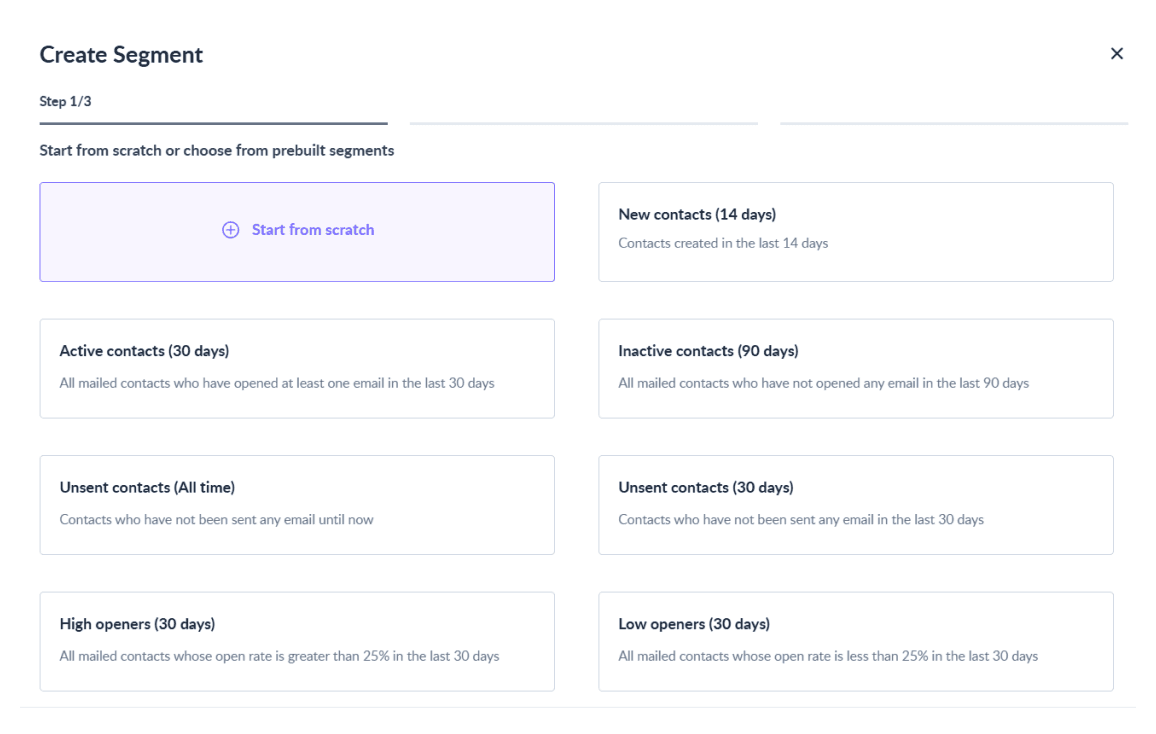
Step 3: Enter the name of the segment. Other parameters such as contacts belonging to, segment type, and conditions will automatically populate, allowing you to preview and make changes if needed.
Here, you’ll also need to decide if you want between dynamic and static segmentation. If you don’t know these terms, dynamic segments get updated over time as and when the customers meet the criteria, whereas static segments are updated only at the time of the creation of the segment and don’t change over time.
Once done, click on create condition.
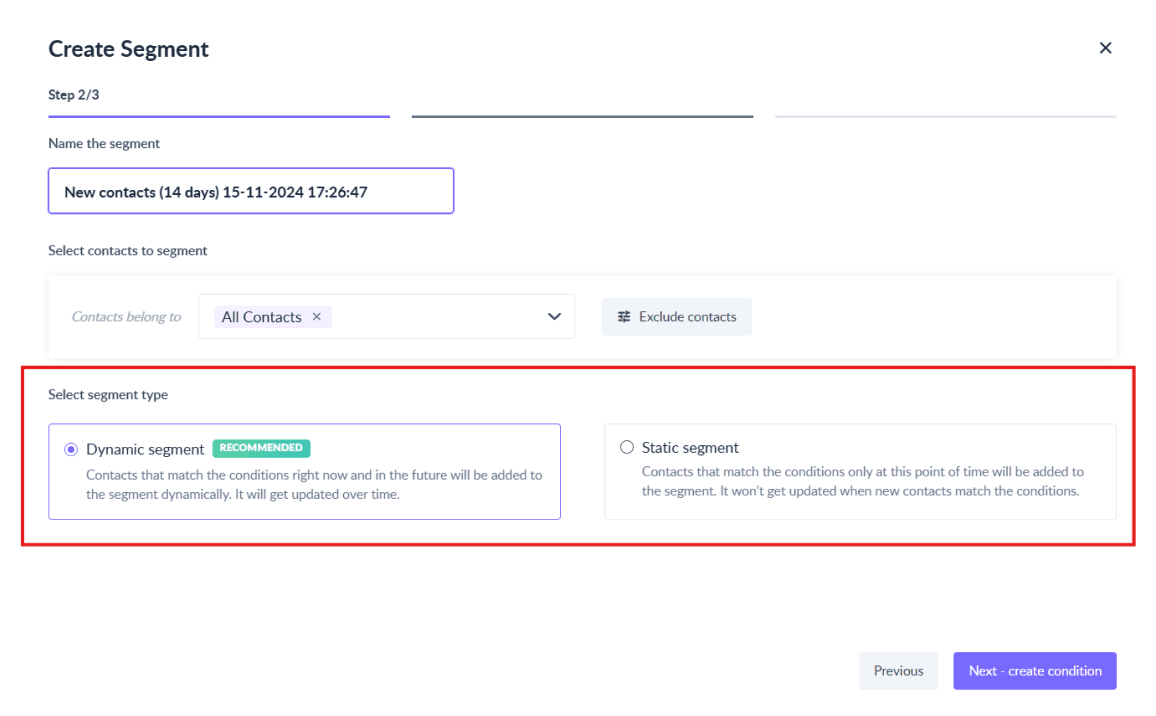
Step 4: Once you have selected the conditions—which will be prefilled based on the chosen criteria, click on Create Segment.
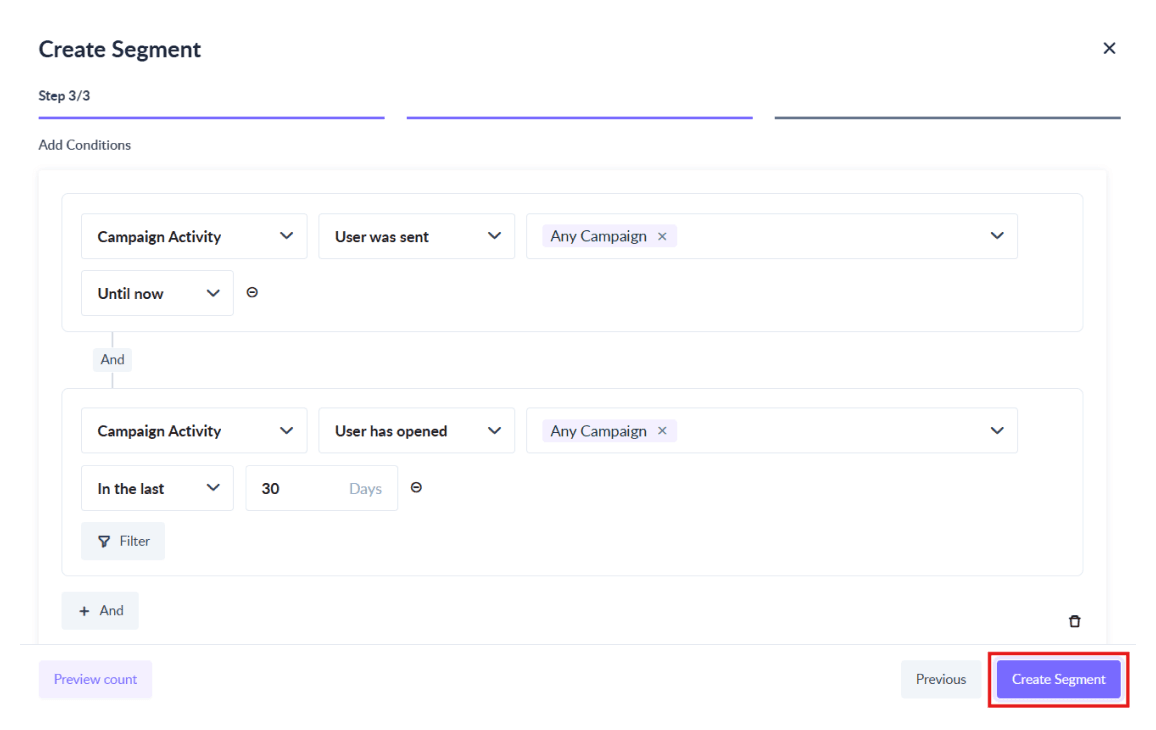
2. Create a segment from scratch
Step 1: Go to Contacts and click on Create Segment.

Step 2: Choose the option to start from scratch.
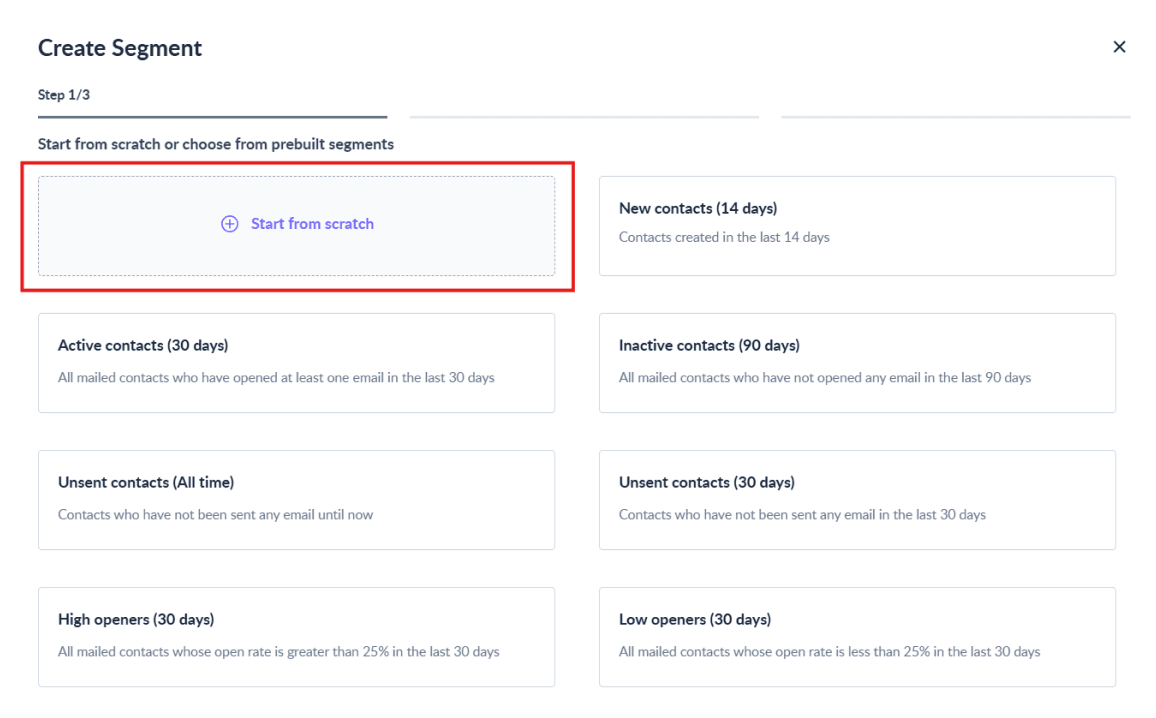
Step 3: Input the segment name and fill in relevant details. Now you need to choose between dynamic and static segment like we did before. Then click on Next - create condition.
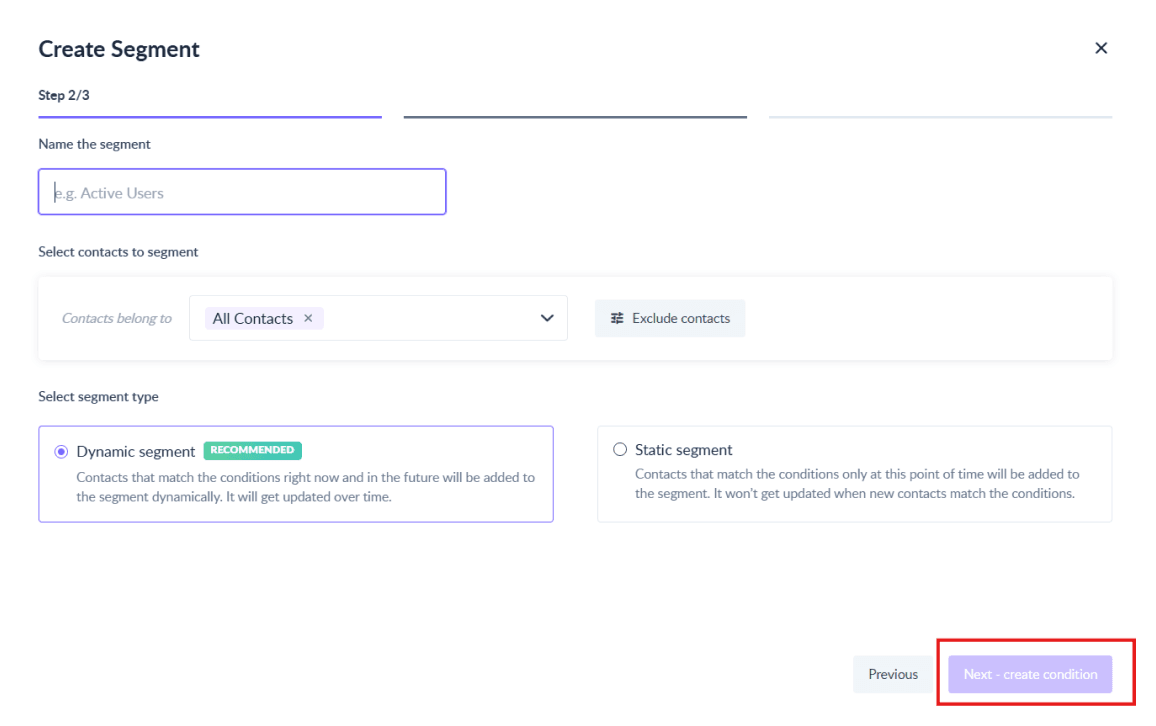
Step 4: Add the conditions here. You can add more conditions and go with Or conditions too. Then click on Create Segment.
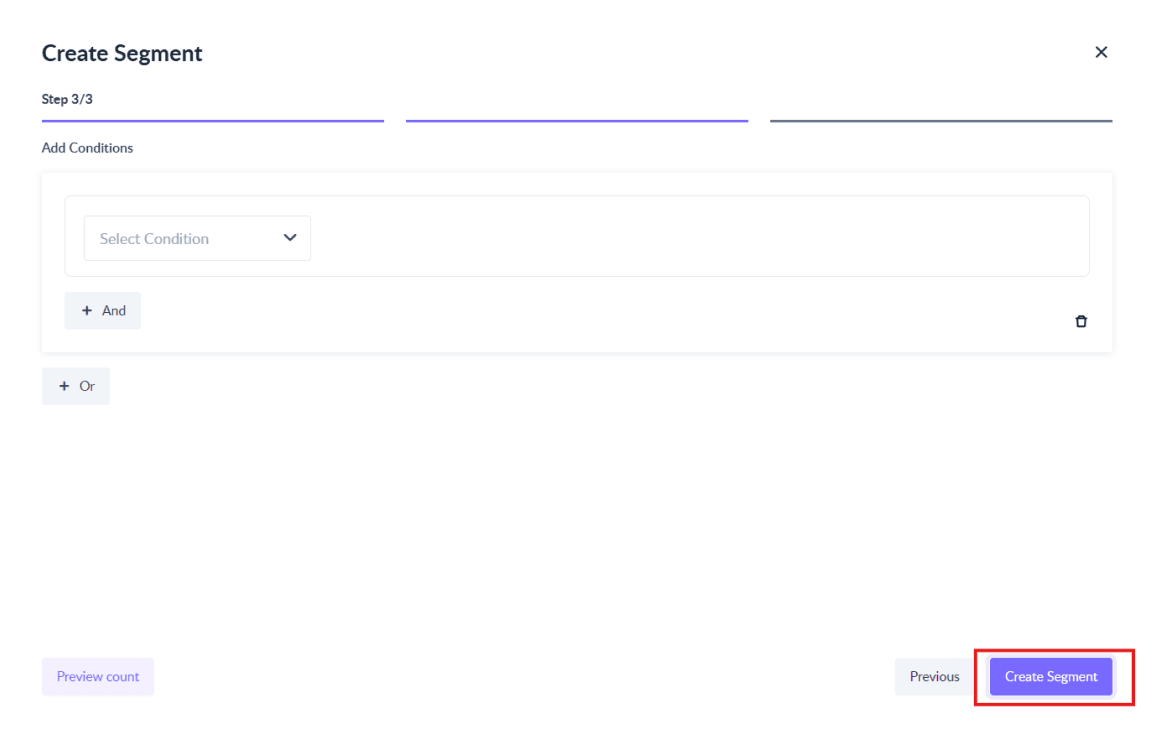
Once done, the segment you have created will be displayed under Segments and lists as shown below.
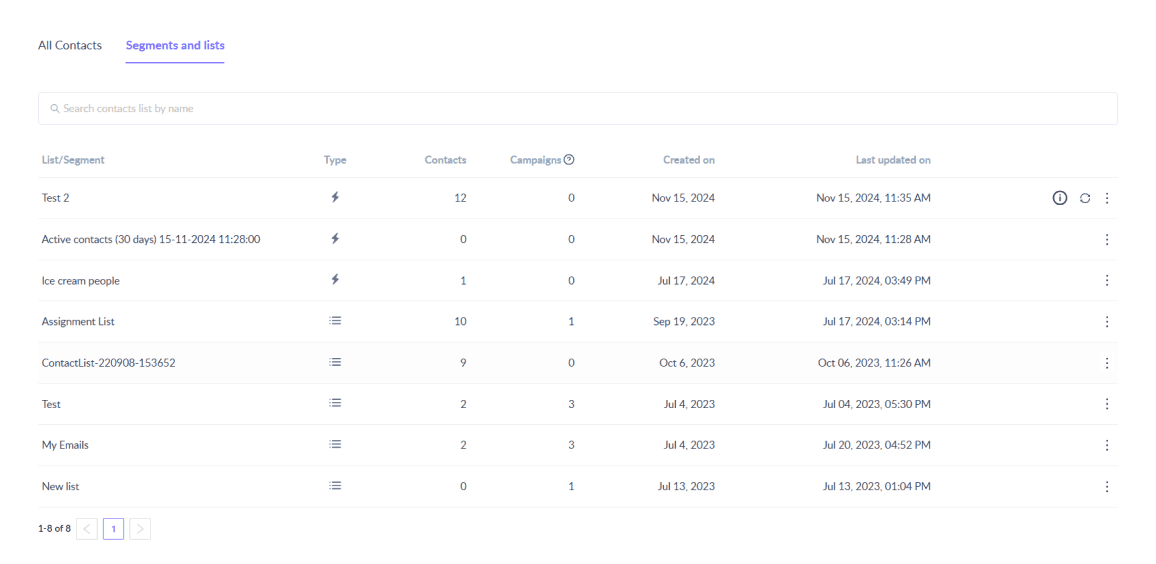
Create and send targeted interactive email campaigns in minutes
Conclusion
By segmenting customers, businesses can understand and cater to the needs of different groups within their customer base. Meaningful segments help you create promotions and campaigns that resonate with their target audience, thereby leading to higher engagement, sales, and profits.
If you're into email marketing, tools such as Mailmodo make it easy to segment customers and help you better understand your data, optimize marketing resources, and improve customer experiences.



 Segments are created based on specific criteria. Below, we’ve provided a table outlining these criteria.
Segments are created based on specific criteria. Below, we’ve provided a table outlining these criteria.

















